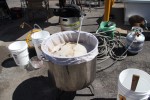Why everyone who has brewed at least once should enter the Kentucky State Fair
 From the fried frog legs at Mike Linnig’s to the livestock shows, the spam cook off and ugly lamp contest, the Kentucky State Fair has given us over 100 years of entertainment, probably bad-for-you-but-oh-so-good food stuffs, and the chance for anyone to walk away with a coveted blue ribbon in a plethora of contests. Of these noble competitions, one has always had a special place in my heart: The Home Brew competition.
From the fried frog legs at Mike Linnig’s to the livestock shows, the spam cook off and ugly lamp contest, the Kentucky State Fair has given us over 100 years of entertainment, probably bad-for-you-but-oh-so-good food stuffs, and the chance for anyone to walk away with a coveted blue ribbon in a plethora of contests. Of these noble competitions, one has always had a special place in my heart: The Home Brew competition.
Started in 1992, the early years saw only a few dozen entries. In 2013, the competition had over 500 entries in 28 categories that explore various brewing styles and certainly give the judges a lot of choices when picking the 1st, 2nd, and 3rd places for each category. The Kentucky State Fair, much like many large-scale home brew competitions, is a Beer Judge Certification Program (BJCP) sanctioned event. The BJCP an international, volunteer program that has helped create beer style guidelines and a systematic way of judging beers so all entries get a fair assessment relatively free of the personal opinions and beer preferences of the judges. Just because a judge doesn’t like a certain style doesn’t mean the entry should get any less fair of an assessment.
Home brew competitions, specifically BJCP, tend to focus on style, presentation and the brewers’ capability to create something that replicates commercial examples. Some may argue that this limits a brewer’s creativity, but I believe it makes the brewer’s creativity come out the most while following the rules, and keeps all the competitors on a respective level. Brewers can always use whatever ingredients they like and can put whatever spin on the recipe they choose, but a beer in competition may be deemed “Not To Style” and the brewer can lose points despite the tasty addition. A lot of brewers simply do whatever they want for the majority of batches, but when the time comes they’ll brew a “competition beer.”
For home brewers, the competition can be more than the glory of taking home a shiny new ribbon and the associated bragging rights. A competition is a way to have his or her beer evaluated and then described back to the brewer. If the brewer shared this beer with friends and family any feedback will most likely have a positive spin, mainly because most everyone loves getting a free beer. Anyone who has brewed at least one batch of beer should enter. They only need (2) 12 oz bottles, no labels with nothing on the caps. The cost is $8 and you can enter up to 28 beers (one entry for each category). The entries come primarily from Louisville, but we’re seeing a lot more from Lexington, Covington, Bowling Green, even as far out as Paducah. Most brewers in the competition are dealing with similar brewing variables: the type of water you use, the temperature you’re fermenting, even where you buy your ingredients. All the personal experience, the beer tastings, the recipe tinkering, that trip to Belgium where you spent hours talking with that awesome brew master all go away and are replaced with a 12 oz. brown bottle. The judge is told the beer’s style and, then, what lies inside is all the judge knows about that beer. The score is out of 50: 12 points for Aroma, 3 points for Appearance, 20 points for Flavor, 5 points for Mouthfeel and 10 points for Overall Impression. The judge is not; repeat NOT, looking for what is wrong with the beer. The judge is analyzing the beer that sits before them at that moment in time. If there are problems with the color, body, mouth feel, aroma, taste or aftertaste the judge should notice them and absolutely write them down, but it is not the job of the judge to set out to find flaws.
“I don’t think I’m ready for it.” “I haven’t brewed enough batches yet,” or the old standard, “well, maybe next year” just don’t cut it. First and foremost, anything can happen. 1st places and Best In Shows have gone to first time competitors plenty of times. A good beer is a good beer no matter who makes it. Second, the judge does not know your life story, whether this is your first beer or 1,000th, whether it is your own recipe or just something out of a book and, especially, whether you did everything you possibly could to ensure the beer’s perfection or just winged it. The judge will examine and assess the beer that sits in front of them, that is all. And, thirdly, you may not win, but you will definitely get feedback. Feedback from someone who is going to point out things you may not notice and possibly even give you ideas on how to fix it. The feedback is the greatest prize and certainly a lot more useful than a colorful ribbon.
At the end of the judging there is an award ceremony where the fortunate ones get to have their name announced and receive their ribbon. Of the 28 categories, the winners of the first 23 categories go on to compete in Best In Show (Categories 24-28 are Cider and Mead and have their own Best In Show). The winner of Best In Show for beer gets to stroll on over to Apocalypse Brew Works and brew a commercial batch that can be sold to the public. Winning is a lot of fun, but the knowledge you get from each entry is what will make look with consideration and with new ideas for the next brew. If you brew, enter the Kentucky State Fair Home Brew competition and don’t be afraid to learn something new.
July 1st – Deadline to Register you beers – www.kystatefair.org
Aug. 6th – Entries Due – South Wing Convention Center 10:00-4:00
Aug. 8-9th – Judging – Awards will be given on the 9th.





